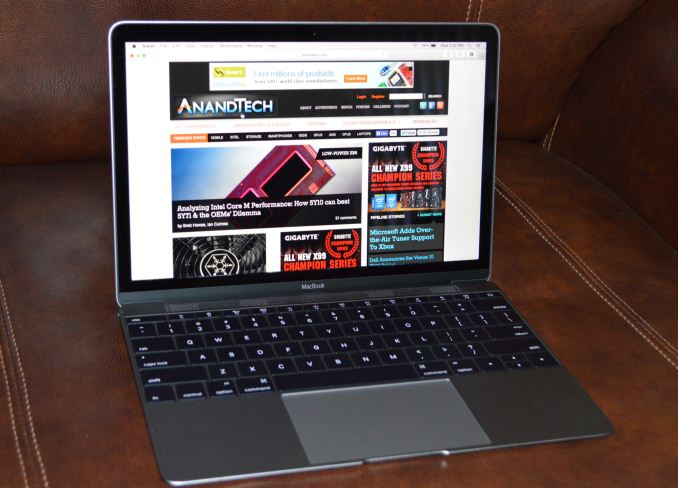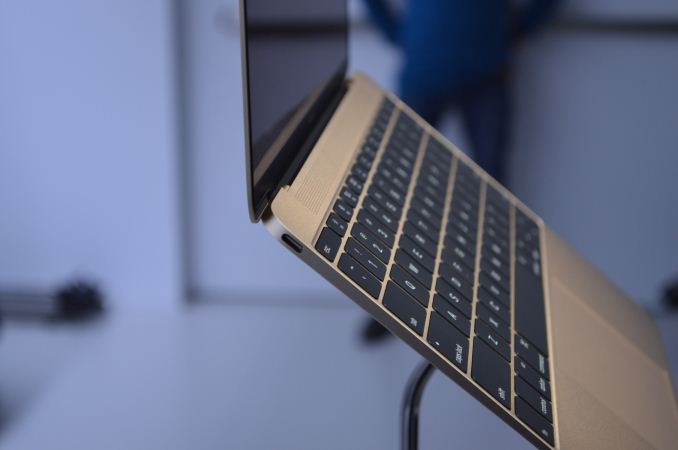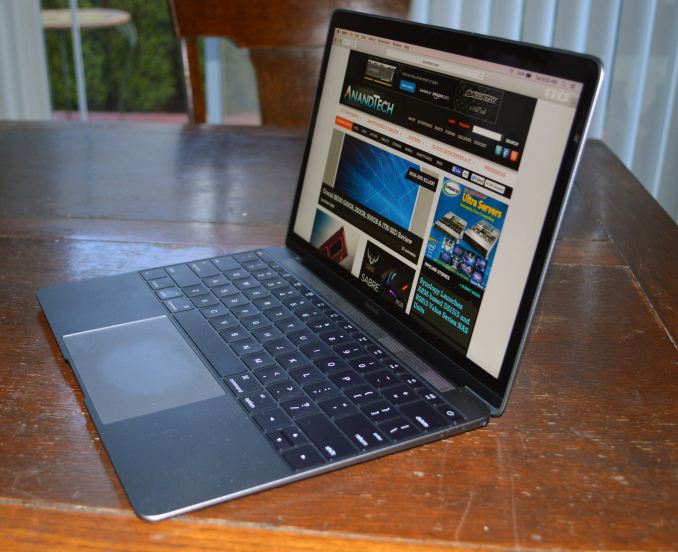The 2015 MacBook Review
by Ryan Smith on April 14, 2015 10:15 AM ESTFinal Words
Bringing this MacBook review to a close, I’m going to start where I left off in our introduction, which was the concept of the laptop/tablet crossover. The idea of laptops and tablets crossing over is no longer merely an idea, but now it is reality. Apple for their part may not be doing any kind of wild 2-in-1 transforming design, or even pushing the concept of a touchscreen OS X device, but they have clearly tapped their immense experience with tablets in putting together the new MacBook.
From a design perspective then the end product is clearly a Mac laptop, but it’s a Mac laptop that’s more tablet-like than any before it. From the small size, to the low weight, the choice of a Core M processor, the passive, fanless cooling system, and of course the choice of metallic colors, the MacBook pushes against the line that separates Apple’s laptops from their tablets.
There are of course numerous benefits and drawbacks from this, with some of them being obvious and others a bit more subtle. The biggest benefit of course is the size; the MacBook is a 0.92kg, 1.31cm thick professional grade Mac laptop, with many of great features that come with such a device. If the Retina MacBook Pro were miniaturized, then it would end up looking and behaving a lot like the MacBook that Apple is delivering today.
The biggest drawback in turn is what you give up to pack a full Mac into such a small laptop. Make no mistake, Core M is no slouch, and in bursting workloads can perform very well. But when faced with sustained workloads, a 4.5W processor can only go so far, and it’s not going to be able – nor is it meant to – keep up with the more powerful processors found in the MacBook Air and Retina MacBook Pro. The end result then is performance that’s anywhere between on-par with last year’s MacBook Air to the MacBook Air of a few years ago, depending on the specific task being run.
Meanwhile in the middle are a multitude of new technologies being first introduced in this generation. The new keyboard and its butterfly mechanism are certainly different, and the reduced key travel takes some getting used to, but once accustomed to it I like the stability of the keys. Similarly, the new Force Touch Trackpad is mechanically very different, and I’m still not sold on whether Apple is going to be able to find too many useful situations for the force touch capabilities. But on the other hand I’m definitely impressed with how natural the trackpad feels despite lacking a true switch mechanism and recreating that feel with an electromagnet instead.
Also deserving of attention is the MacBook’s 12” Retina IPS display. Particularly since the move to Retina Apple has been doing a great job on producing high quality pro displays, and the MacBook’s doesn’t fail to impress. The MacBook’s display’s out of the box performance is among the best we’ve ever seen, rivaling (and at times exceeding) the Retina MacBook Pro, which is to say that the end product is a very accurate, very sharp display. Mac users have been clamoring for a Mac ultra-portable with a Retina display for some time now, and although I don’t think the MacBook was quite what everyone had in mind, the MacBook’s display certainly is.
And then there’s Apple’s introduction of the USB Type-C port, which on such a small laptop like the MacBook takes on a whole new importance. Apple has always been on the cutting edge of I/O and their rapid adoption of USB Type-C is no exception. Relying on it for both I/O and charging is in turn a logical move given the interface’s capabilities, but I would also have to argue that Apple has taken it too far with just a single Type-C port. The Type-C port was the right call – teething issues and all – but Apple has unnecessarily hindered the MacBook by only giving it the single port. Even with its small, ultra-portable design there are still times where it’s desirable to charge the MacBook and use it with an external peripheral at the same time.
What we’re left with is a solid, though by no means perfect new entry into the MacBook family. I hesitate to call the MacBook a niche product since niche implies highly specialized when in fact the MacBook isn’t quite that specialized – it’s just small – but it’s clearly one product in Apple’s larger lineup. What the MacBook isn’t is a replacement for the Retina MacBook Pro or MacBook Air – at least not today – as it’s a laptop for users who already have other laptops or desktops; it is a second computer, not a first one. And admittedly this is the same designation that was applied to the MacBook Air on its launch several years ago, but as the Air’s performance has improved over the years and it was shifted to Apple’s entry-level laptop, it has certainly become the sole computer for an increasing portion of its user base.
Speaking solely for myself here, I’ve come away rather impressed with the MacBook. As an 11” Ultrabook user I already have a fondness for the weight and size of the form factor, and as a journalist frequently carrying around a laptop to trade shows and meetings I particularly appreciate the reduction in weight. The regression in performance is unfortunate, but the combination of weight, battery life, the Retina display, and the keyboard in my mind more than make up for the performance the MacBook can’t offer. After all, I have a workstation for when I need performance; what the MacBook fulfills is delivering acceptable performance when I’m away from that workstation and need portability over performance.
Briefly, I also want to touch on price. The MacBook’s $1299 starting price tag is very much an Apple price tag – which is to say expensive – however it’s also one that goes hand-in-hand with markedly improved base specifications for an Apple laptop. The 11” MacBook Air starts at just $899, but as Apple’s entry-level laptop I will also argue until I’m blue in the face that it’s underequipped for 2015; 4GB of RAM and a 128GB SSD aren’t enough. Which is a point I make because after upgrading the Air to a more acceptable 8GB of RAM and a 256GB SSD the price tag is up to $1199, at which point it’s only $100 off of the MacBook. At least compared to the rest of Apple’s lineup I find that the base MacBook isn’t so much expensive as the base MacBook Air is just a bit too cheaply built.
Anyhow, on a broader note, while I doubt Apple was looking quite this far into the future when they created the initial MacBook Air, I get the distinct impression that this is the kind of device they have been building towards. Apple has always been held back by technology to some degree – be it processor size, storage size, or display power requirements – and it’s only now in 2015 that the pieces have come together to allow them to make a laptop this small. I don’t believe this is a stopping point for Apple simply because one way or another they’re going to keep iterating, but compared to the MacBook Air there isn’t the same need nor ability to make a MacBook even smaller.
Which brings me to my final point, which is the future direction of the Apple’s Mac laptop families. The fact that the MacBook is the MacBook, and not the MacBook Nano or some other named MacBook is something I believe is telling. Although there’s clearly a risk in reading too much into Apple’s future plans based on a name alone, I have to seriously wonder where the MacBook and the MacBook Air go from here. Apple still needs an entry-level Mac laptop, but do they need the MacBook Air in particular? Just as the newer MacBook Air rendered the previous generation MacBook redundant in due time, I suspect Apple may intentionally following the same course with the new MacBook. But as to whether that comes to pass, only time will tell.













354 Comments
View All Comments
modulusshift - Tuesday, April 14, 2015 - link
Dudebro, Anand's out. He's at Apple now.Ooh, performance over time would have been good.
Definitely with you on the performance per watt and silence, Apple has never been more environmentally friendly.
That said, I don't think this review was bad. Could have used a little more editing, and discussion of the different models as you said. But it had some good material I've yet to see in the rest of the reviews. I wish it lived up to the standard of Anand's review of the SP3 where he gave more of his subjective opinion of how it actually ran. This guy said, yeah, it's thinner and lighter, and I like how it feels, but it's slower than my current 11 inch, so there's a little bit of a tradeoff... And I wonder, why is it slower? Is it actually less capable? What sort of experiences didn't work as you expected? What is really wrong with it?
wave84 - Tuesday, April 14, 2015 - link
The point is I didn't see anything here that I haven't already read on all the other websites all the way from New York Times to the Verge to ArsTechnica. The reason we all visit AnandTech is for those really detailed, in depth 25 page reviews where every single one of our questions gets an answer. Not the case here.The reason why I'm being so determined is that this is a very important review. Like it or not, Apple fanboy or not, the Macbook Air has probably been the most important laptop of the last 10 years. It has basically defined the laptop market of our times and it has been studied, copied and emulated by every manufacturer out there.
Similarly, the new Macbook is probably on a quest to do the same. I would have preferred to wait 2 weeks and read the real thing, not the same article that I've already read 10 times so far (by the way, isn't it strange that all these articles are so similar?)
I'm in a strange boat myself. Started out getting a 2011 13" Macbook Air as a secondary computer, then it slowly transformed into a desktop replacement with an external monitor with the old desktop sold for parts (doing web development, mostly). I would currently kill for the weightlessness / screen / quietness of the Macbook, if the questions above would have been answered. Should I go for the updated 2015 Air? A somewhat bulky Pro? Or maybe just wait for Skylake?
Why have you deserted us, Anand?!... :)
BillBear - Tuesday, April 14, 2015 - link
I don't get the feeling that this would be a viable desktop replacement if you're at all concerned about gaming.lilo777 - Tuesday, April 14, 2015 - link
Hence the term "hybrid". This device is not good either as a desktop replacement or a tablet replacement (or even as a regular laptop replacement). It's a "hybrid" then (probably good for nothing).Ryan Smith - Tuesday, April 14, 2015 - link
Hi Wave, thanks for the feedback. To get right to answering your questions.1) This was the base model, so the $1299 5Y31 model. Apple only samples a single model, so I do not know how the higher end model would fare. However what we've found when looking at other Core M devices is that faster processors can end up throttling sooner, which can be counter-productive. http://www.anandtech.com/show/9117/analyzing-intel...
2) If a load is going to cause the laptop to throttle, it does so almost immediately. As noted in the review, even the 28 second Photoshop benchmark is long enough to require some throttling. As a result pretty much anything longer than a long webpage load is going to face power limits, and longer use will also bring on thermal limits.
Also, while it's not in a chart, I mentioned in the Geekbench 3 section that we ran the stress test. the MacBook reaches equilibrium almost immediately; by the second run it's already down to its steady-state score of 4200.
What this means is that the MacBook can only run at its higher clockspeeds for very, very short periods of time. As a result "performance over time" would be on the order of seconds. This isn't like an Ultrabook or other laptop where performance slowly degrades over time as the cooling system slowly falls behind.
3) Poorly. I wouldn't suggest it. DOTA 2 is about as strenuous as it's going to be able to take. Unfortunately we can't test any of those games as there isn't a suitable FRAPS-like utility for Yosemite to let us do proper benchmarking.
4) The issue with testing efficiency is that to properly test it we need to isolate the CPU and measure it directly. You're not wrong, this is a very efficient processor, but there isn't currently a great way to systematically show that since there's no way to separate the CPU's power consumption from the display's power consumption.
Anyhow, I'm sorry to hear the review didn't live up to your full expectations, but none the less thank you for the feedback and thank you for reading it.
wave84 - Wednesday, April 15, 2015 - link
Thank you for answering all of my questions, Ryan. I withdraw all my complaints :)Kevin G - Wednesday, April 15, 2015 - link
3) I thought Apple's developer tools for OpenGL has a FRAPs-like tool included. I'll have to check when I get home later today.I do know for certain that it has the ability to record VRAM usage over time. Found this out playing around with a GTX 770 and 970 to see just how difficult it was to go over 3.5 GB.
Ryan Smith - Thursday, April 16, 2015 - link
It shows you the frame rate, but it doesn't allow you to record it to find the average frame rate over time.yticolev - Wednesday, April 22, 2015 - link
Hi Ryan, thanks for the excellent review. It supplied details that no other review did. I do have one question that I was hoping would be addressed and that wave84 also asked: buying advice related to Skylake. If what I read is correct, Skylake will be out in just a few months with significant changes to chip architecture promising both better performance and battery life. Better GPU is part of that. It would kill me to purchase now and miss out on an extra hour of battery life with a midyear update.I certainly can wait. I have a perfectly cromulent late 2007 Blackbook that I have not been tempted to upgrade until this new MacBook (which is a huge upgrade to be sure). Now I've got buying fever despite the hassle and expense of upgrading a number of applications that require Rosetta.
One other very minor point, I was surprised you didn't mention iSight as it is a downgrade over other current Apple machines.
modulusshift - Tuesday, April 14, 2015 - link
Replaceable instead of replicable, page 2table instead of cable, DisplayPort instead of DisiplayPort, page 6
could you fix the number for 2010 MBA (last entry) in the 4KB Random Write (8GB LBA, QD3) chart? page 8
tuning instead of turning page 9
On the one hand instead of For one the one hand, second to last page as mentioned by earlier comment.
Thank you for your review.